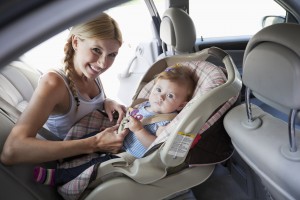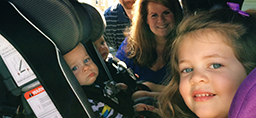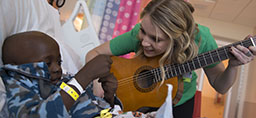
Most of us are ready to see wintery weather get out of town.
At the same time, warmer temperatures, dry roads and spring fever make us ready to get out of town, too—or at least get out of the house.
Before you pack the family into the car, it’s a good time to do a crew check.
- Are your kids riding in the right safety devices?
- Are the devices still working correctly?
- Do you even know what those seats actually do to protect your kiddos?
While most parents want to do the right thing, it’s easy to overlook the significance during frazzled take-offs. It’s also likely that many parents aren’t aware of how car seats and boosters actually work.
Helen DeVos Children’s Hospital in-house safety expert Jennifer Hoekstra gets straight to the heart of her mission.
“There is never a time to back off on your commitment to do car seat safety right,” Hoekstra said. “I could connect you to stories of families who would give anything to be able to turn back the hands of time.”
Three big reasons why car safety for kids matters:
1. Rear-facing car seats reduce the likelihood of incapacitating injury or death by 71 percent.
This does not mean that car seats fail 29 percent of the time.
It means that if you use the car seat correctly, you have reduced the risk by 71 percent of your child being injured or killed in a crash.
2. Forward-facing car seats are effective 54 percent of the time in reducing incapacitating injury or death.
“We have to ask ourselves seriously why we are so quick to go from rear-facing to forward-facing seats,” Hoekstra lamented. “Once you flip your child around to face forward, the protection from the shell of the seat (which acts as a huge shock absorber when rear-facing) is gone. Your child is now only protected by the harness straps. Properly fastened, they will hold your child, but there is no additional shock absorption benefit.”
The strong protest from parents is that tots’ and kids’ legs can’t stretch out in a rear-facing seat.
“They could break their legs,” parents insist. Hoekstra dismisses this immediately, with more facts.
“This is completely unfounded,” she said. “Tests and statistics prove that in a crash involving a forward-facing seat, kids’ legs rebound upward, easily snapping the femur. In a crash with a rear-facing seat, statistics show that a child’s folded or bent legs do not break. They simply bend more deeply. A sore leg is always preferable to a broken leg.”
3. Booster seats reduce the risk of incapacitating injury or death by 49 percent.
“The purpose of the booster seat is to position the child so that the adult seat belt rests on the strong bones,” Hoekstra explained. “This is why experts advocate keeping kids in a booster for as long as possible, even if they meet the age requirement of the law.”
She illustrated, “If you buckle your 8 year old into the regular seat of the car using the seat belt, where does it fall on his or her body? It is very likely going to rest across the soft abdomen and across part of the neck. In a crash, that seat belt will contract until it hits something hard. For children restrained in this fashion, that means it would be both the cervical spinal column and the lower spinal column that would absorb the crash. A booster allows you to ensure the belt crosses the hip bones, the sternum and the collar bone. All of those points, in a crash, will take the brunt of the force. This is the kind of protection you want.”
 /a>
/a>
 /a>
/a>
 /a>
/a>